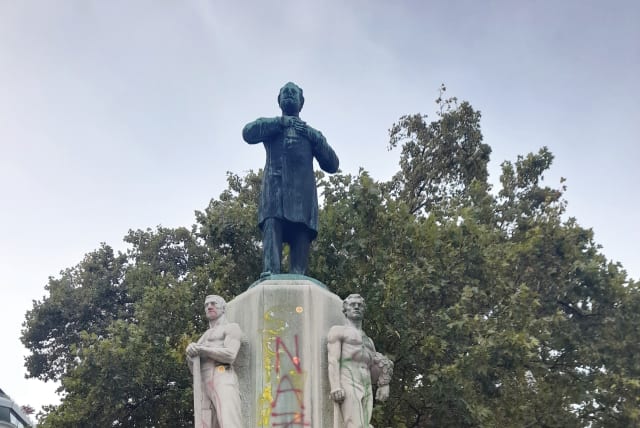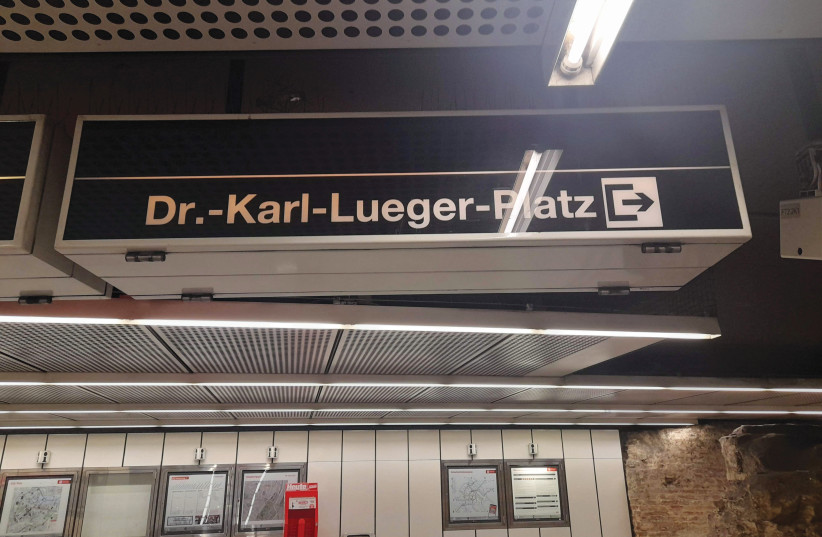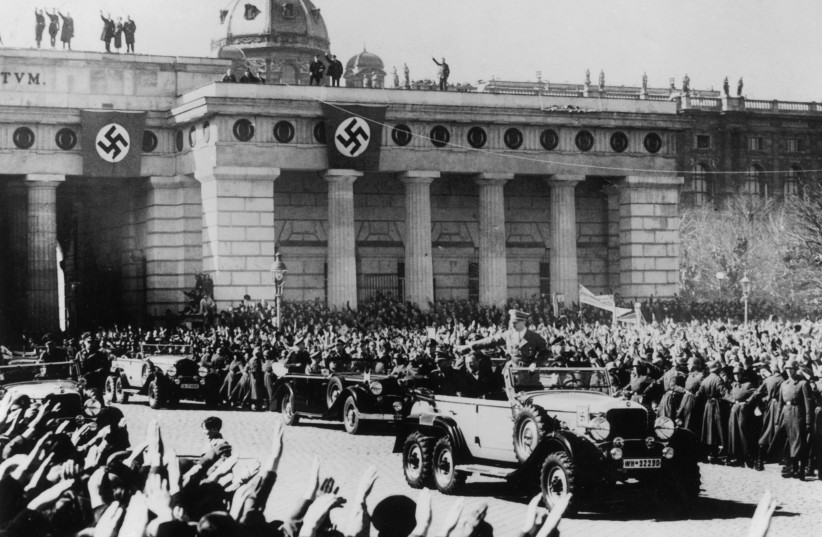Adolf Hitler’s country of birth salutes Karl Lueger, a mayor with a checkered past

Ode to an antisemite: Preserving a towering tribute to one of Hitler’s sources of inspiration
My mother was born in Vienna. The only reason I am alive is because she escaped on a Kindertransport to England, together with her two sisters. Her parents and younger brother and sister were all murdered in Auschwitz.
Over the years I visited Vienna many times, trying to (re)connect with the place where my mother spent the first seven years of her life, trying to fathom my ambivalence and to reconcile myself with a city that became both a familiar second home and a place where my Holocaust trauma began.
It has been a constant struggle, as my emotions oscillated between a sense of gemütlichkeit – coziness – and abhorrence at the not-so-distant past. After all, it happened during my 91-year-old mother’s lifetime, so it is not exactly a matter of dredging the mists of time.
Naturally, the current younger generation of Austrians, and my own contemporaries, were not around when their compatriot, Adolf Hitler, was stirring up antisemitism and racist fervor of every ilk. But how does Austria of 2023 relate to all that? Is it, at long last, ready and able to face up to its murderous past, deal with it, and fully admit its more than willing contribution to the “Final Solution”?
Judging from conversations I had in Austria a few months ago, and eyeing the Karl Lueger monument from close quarters, I believe the answer, sadly and terrifyingly, is in the negative.
Who was Karl Lueger?
LUEGER WAS mayor of Vienna between 1897 and 1910. By all accounts, he did a good job, modernizing the imperial capital’s utility infrastructures, caring for some of the city’s downtrodden, and developing green lungs. But, besides being a highly capable and popular mayor, Lueger was also a rabid antisemite.
His professional achievements were marked, for all to see and marvel at, in the form of a monument erected in the center of Vienna in 1926. The spot was named after him – Karl Lueger Platz – as was a section of the famous circular boulevard route that runs around the city center, aka the Ring. But this is not just any old salute to a yesteryear A-lister. The brass statue and stone plinth is an enormous structure. The base features high relief scenes which are more reminiscent of Stalinist USSR and other totalitarian regimes that deify their omnipotent rulers.
“It is not a regular monument. It is a tribute,” notes Benjamin Kaufmann.
Kaufmann serves as the head of the Vienna office of LICRA, the Paris-based International League Against Racism and Antisemitism, founded in 1927 to combat intolerance, xenophobia and exclusion. Over the past three years or so, Kaufmann and his team have invested much time and effort in tackling the lauding of Lueger in the Austrian capital. For example, they hosted an in-depth symposium on the issue in November 2021 at Mumok, Vienna’s museum of modern art.
On the most basic – possibly simplistic – level, it is surprising that there is even a debate about this. What could possibly be more clear-cut than getting rid of a gigantic glorification of an antisemite? And in Austria! Surely, no one in their right mind, in 21st-century Vienna, over three decades after Austria finally officially abandoned its claim that it was “the first victim of Nazism” and owned up to having been a willing contributor to the Holocaust, could continue to support the existence of unashamed celebration of someone whom Hitler himself called “the greatest German mayor of all times.” And that was in Mein Kampf, the notorious autobiographical manifesto of the Nazi Party.
Rather than summarily removing the statue and accoutrements from its central urban location and either destroying it or placing it somewhere less prominent, the Vienna Municipality touts the idea of “recontextualization” and of leaving the monument there as a reminder of racism and prompting discourse about it.
But what of the Jewish community in Vienna and its various officials? What are they doing about it? I was perplexed, if not astounded, when my requests for a response from leading figures in the Jewish community to the very existence of a place of honor to an antisemite who actually called for the murder of Jews went unanswered. I can appreciate that, whether we like it or not, at the end of the day, one has to play the political game. One might hypothesize, for example, that were Oskar Deutsch, president of the Jewish community and the Federal Association of Jewish Religious Communities in Austria, to make too much noise about the Lueger issue, that might put a few municipal noses out of joint. That, one might surmise, could generate some negative budgetary backlash for the community. Of course, that is just my uneducated apolitical speculation, but the resounding silence left me with troubling question marks.
I hoped to get some recognition from the powers that be in Vienna, and duly corresponded with Veronica Kaup-Hasler, executive city councilor for cultural affairs and science. I asked her what she says to people who want the monument removed. Kaup-Hasler opts for the notion that it is better to confront rather than erase. “History inscribes itself on the city in the most diverse ways,” she notes somewhat superfluously. “I think it is difficult to remove these testimonies, even if they are painful for us. By withdrawing them from public view, we would lose the opportunity for an ongoing discourse.”
DELETION BECAME a corporeal issue when the Schandwache – Shame Watch – activity began in the summer of 2020. It was initiated by an interdisciplinary artist group as a response to the spraying of graffiti on the Lueger work, including words such as “schande” (shame) and “Nazi.” The municipality initially had the graffiti removed but then decided to leave subsequent textual protests, in line with the aforementioned political ethos of utilizing opposition to spark presumably healthy and productive discussion.
Some agree with the municipal view and say that such memorials should remain as a reminder-reference point of the past and the lessons to be learned, to ensure that, for instance, the Holocaust does not recur. Indeed, the Schandwache group wanted the graffiti left in place to draw attention to the evil baggage inherent in the artistic landmark. The protest was joined by Muslims and others.
But where does one draw the line? Perhaps there should be a monument in Vienna to Hitler, who was, after all, an Austrian who did “great things” for Germany and Austria, pulling them out of the deepest economic recession and putting them on the map – literally – almost the entire European map. Surely that would help to keep us aware of his demonic deeds and ensure that the Holocaust does not get a reprise. Would, one wonders, Kaup-Hasler and her colleagues in the municipality support such an initiative? After all, we do want to generate discussion about antisemitism and other forms of racism, don’t we?
And while we are on the subject of reminders, why does Vienna not have a Holocaust museum? There is a Jewish museum, but that is predominantly devoted to Jewish history and culture, as it should be, and does not focus on the murder of six million Jews between 1933 and 1945.
What, to the mind and emotions of this son of a Viennese-born Holocaust survivor, seems an egregious – if not evil – case of misjudgment or downright foolhardy decision may, in fact, be far more complicated. One has only to cite the fact that Stefan Zweig himself, famed Jewish Austrian writer, who fled Austria in 1934 and, despairing of hope for Europe, committed suicide in Brazil in 1942, said of Lueger that “his city administration was perfectly just and even typically democratic.”
In addition to my attempts to get a feel for the stance of Jewish officials in Vienna on the ongoing memorial saga, I got some surprising and disappointing street-level observations while I was there. When I talked to an Israeli resident of Vienna about my consternation concerning the ongoing presence of a gargantuan salute to an antisemite, her retort went something along the lines of: “There are lots of statues to antisemites all over Vienna. If you get rid of them, what would be left of history here?” When I suggested that this raises serious questions about Austria in general, she just raised her eyebrows and changed the subject. Perhaps the head-in-the-sand approach is one way of making life in Vienna, as a Jew, possible.
I also ran into a couple of non-Jewish fellow cycling enthusiasts – funnily, both called Andy – on a train. We got to talking about Austria’s recent Holocaust-related past, whereupon one observed that most Austrians either don’t want to know about it or “are very happy about it and think it was a good thing.” Needless to say, I was left with my jaw hanging and a sense of total disgust.
Keeping quiet
SIMON NAGY, a non-Jewish Viennese artist from the Schandwache group, says efforts were made to keep the Karl Lueger issue under wraps until the municipal elections, held on October 11, 2020, were safely done and dusted. That included barricading the monument off and keeping protesters at arm’s length. “We had 15 different activist groups. We had Jewish students and Muslim youth, and Social Democratic youth and Green youth. We also had performance, with theater groups. It was really quite diverse. We held a vigil of disgrace.”
That had some effect. “During the week we were here, the Municipality of Vienna said they [graffiti] were going to be left, and until they [the monument and graffiti] are going to be contextualized or rebuilt, they are going to stay there.”
Nagy does not support that idea. He and his colleagues would prefer something a lot more radical. “The municipality said that after the autumn of 2022, they are going to have an open call for permanent artistic contextualization of this, whatever that means. I think 15 artists were invited. Our group was one of them, so we know the wording of the contextualization.
"When I visited the square, one of the candidates for the artistic recontextualization slot was there in full polychromic skeletal wooden glory. It was a very large strange-looking work with more air to it than actual tangible structure. My impression was that, while it was incongruous, it did nothing to offset, overshadow or draw the eye away from the Lueger tribute. It just looked weird. Admittedly, I have not seen any of the other entries, but if that one is anything to go by, I don’t hold out too much hope for a successful recontextualization, at least on aesthetic grounds."
Kaufmann is also skeptical about the municipality’s plans for the square. “I am not against artistic contextualization in general. I don’t think it can work in this particular case for several reasons.” The LICRA official returns to the monument-tribute dichotomy. “This is a tribute. It was designed as such. It wants to be that. It is huge. A small intervention is not going to change anything about that. It is not going to make it into a place where the Jewish population of Vienna is comfortable.”
That is, of course, a salient point and one that the authorities do not appear to be willing to address. Shouldn’t they be asking those who find the monument offensive what they would like to be done with it? In fact, a letter was sent to the municipality; the signatories included Holocaust survivors, demanding the removal of the statue. It went unanswered.
And what about renaming the square? The aforementioned section of the Ring, after much to-ing and fro-ing and plenty of pressure, was eventually renamed after the local university. Clearly, if there is a will, there is a way.
Kaufmann also notes that any ideas about redesigning the square, and the statue and base, would have to conform to municipal constraints. “There are very, very strict limitations. The artists who have been invited to it are not allowed to even touch the tribute. They can basically just build something around it. This contextualization has gotten off to a very bad start.”THERE IS another side to the whole venture, which relates to the person responsible for creating the work in the first place, Austrian sculptor Josef Müllner, who later supported Nazi ideology. “I am not saying that, generally, it is impossible to use artistic contextualization, but, in this case, I don’t think it should even be discussed,” Kaufmann adds.
Part of the municipality drive to reimagine Karl Lueger Platz includes the placement of a plaque, in German and English, which advises visitors that Karl Seitz, mayor at the time the monument was installed, called Lueger “a controversial politician.” The quotation marks appear in the original. The text also says, of Lueger, that “populist antisemitism and the supremacy of German nationalism became increasingly important features of his political rhetoric over the course of his career.”
When I explained some of that to a couple of French tourists I met there, they looked at me nonplussed and shook their heads. “How could they put up this statue?” the older one wondered. If that reaction is anything to go by, the municipality missed its mark with the plaque.
Dirk Rupnow, a German historian who teaches at the University of Innsbruck and serves as head of the Institute for Contemporary History there, believes the monument should be removed.
“I have always said it should be removed,” he says, although adding that he does not rule out recontextualization entirely. But that would be a far more radical change than the one envisaged by the municipality. “I could live with it if it really shames Lueger. You could bring it down from the pedestal and put it on the ground.”
As things stand, Rupnow does not see that happening. “From the point of view of the city of Vienna, it seems to be untouchable. I think that is the most problematic thing, to turn it into something untouchable and to argue that we need it so we can be reminded of the fact that there was antisemitism in Austrian history. By the way, there is also antisemitism in the Austrian present.” Not exactly encouraging words, backed by the fact that the monument has been used as a rallying point by Austrian neo-Nazis.
Rupnow feels the problem is systemic across the official Austrian line on its dark past.
“There are a number of Holocaust memorials in Vienna but no museum,” he notes. “The House of Austrian History was created in 2018 after 20 years of discussion. They tried to cover the Nazi history, but there is no museum that focuses on that part of Austrian history.”
Vicky Borochov, president of the Austrian Union of Jewish Students, feels that is just another failure in the error-strewn path Austria has followed since World War II.
“After the war, there was no education here about what really happened [during the Holocaust],” she says. “It was sort of gone, but it was still very much there, still the center of the Austrian mentality.”
That, she says, resonates strongly at Karl Lueger Platz. “He used antisemitism for his populist politics.”
Borochov also feels that the art installation in the square at the time did nothing to counterbalance the monumental tribute. I noted that the new addition actually cites 16 other works dedicated to the antisemite, glorifying Lueger even more in the process. “It cost €100,000 that could have helped so many people to keep their apartments warm,” she points out, at a time when energy rates in Austrian have skyrocketed.
Borochov also mentioned her concern about a surge in antisemitism in Austria, something she experiences personally on a regular basis. “I wear a necklace with a Magen David,” she says. “There are parts of the city where I make sure it is covered.”
Preserving a towering tribute to one of Hitler’s sources of inspiration, in the country of his birth, is a simply stupefying decision that begs public outcry and reconsideration, not recontextualization.
Jerusalem Post Store
`; document.getElementById("linkPremium").innerHTML = cont; var divWithLink = document.getElementById("premium-link"); if (divWithLink !== null && divWithLink !== 'undefined') { divWithLink.style.border = "solid 1px #cb0f3e"; divWithLink.style.textAlign = "center"; divWithLink.style.marginBottom = "15px"; divWithLink.style.marginTop = "15px"; divWithLink.style.width = "100%"; divWithLink.style.backgroundColor = "#122952"; divWithLink.style.color = "#ffffff"; divWithLink.style.lineHeight = "1.5"; } } (function (v, i) { });


